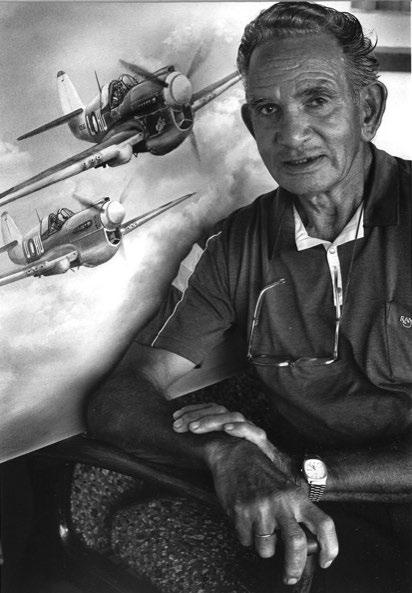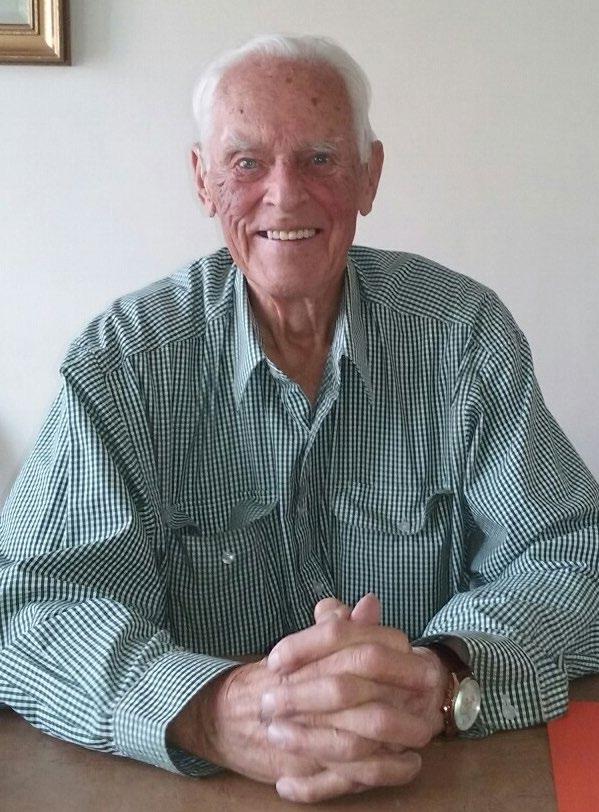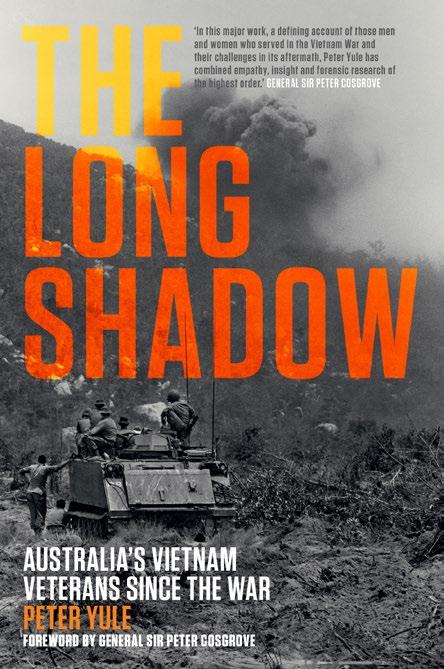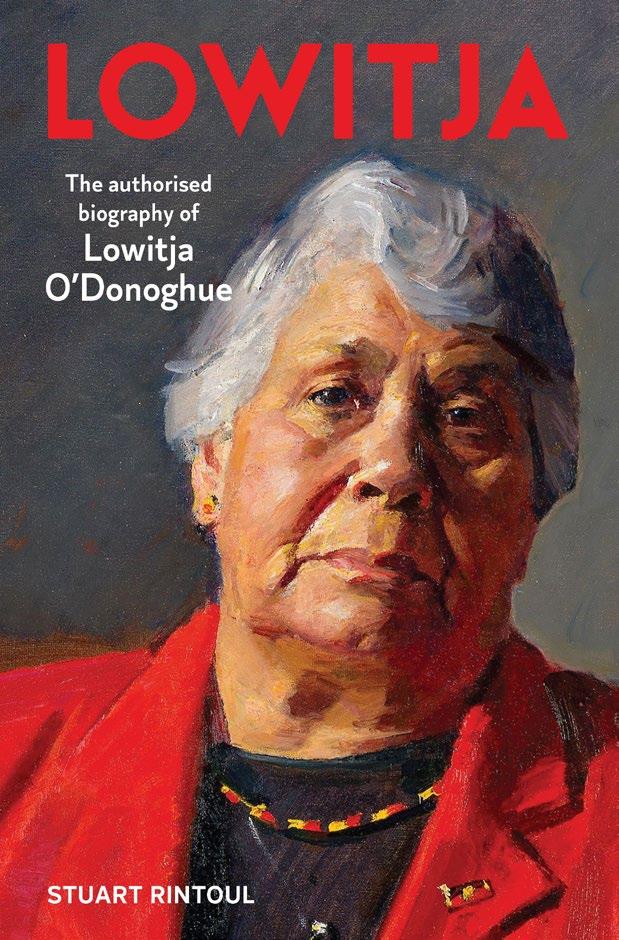
11 minute read
The search for Digger Bennett’s grave – Peter Rees


Advertisement
CLOCKWISE, FROM TOP: Warrant Officer Len Waters, Len Waters in later life in front of a painting of his Kittyhawk, ‘Black Magic’, Len Waters in his cockpit, Len Waters’ Kittyhawk ‘Black Magic’.
The search for Digger Bennett’s grave
Where lies the body of WWI Aboriginal Digger George Bennett, Australian Imperial Force no. 4243?
Like so many Diggers, George paid a heavy price with bad health after fighting on the Western Front. He had proudly worn the AIF uniform, yet died ignominiously in a Mungindi police cell on 24 September 1950, a day after being arrested for drunkenness. In his report of the death, the town’s sergeant noted that George had been “badly gassed” in the war and that he had been “spitting phlegm” before dying in the cell. An autopsy found the cause of death was cardiac thrombosis. George was buried in Mungindi cemetery. He had enlisted at Armidale in April 1916, one of more than 1,000 Aborigines to serve with the AIF during WWI. He saw action in France with the 29th Battalion AIF before being reassigned to the 32nd Battalion, witnessing the horrors of Bullecourt, Ypres and Passchendaele in 1917. He took part in the advance that followed the battle of Amiens, and was gassed as the Germans fought desperately to hold their positions near Mont Saint-Quentin. Released from hospital at war’s end, George was admonished for being drunk in London. He was not alone. White or black, there were few more egalitarian ways to blur the pain of war memories than getting drunk. On his return to the Aboriginal reserve, Euraba, near Boomi in northern NSW, George and his mate Charlie Bird were honoured with a Welcome Home ceremony. One of those who sang what a local newspaper described as “a very nice patriotic song” was his daughter, Grace. Newly married to Don Waters, Grace was the mother of Warrant Officer Len Waters, the first – and only – Aborigine to become a WW2 fighter pilot. Flying the Kittyhawk Black Magic in 78 Squadron RAAF, Len flew 41 strike missions against the Japanese. Len’s brother, Kevin Waters, 92 and George Bennett’s only surviving grandson who lives in St George, Qld, attended his burial, but can’t remember the plot’s location. Kevin Hobday, a retired ambulance officer who has lived in north-west NSW for many years, became involved in the search for George’s grave through Mungindi Elder Barney McGrady. Despite extensive searches, no burial record has been found. Kevin obtained records showing 12 burials in the cemetery in 1950, with headstones for seven, which means one of the unmarked five must belong to George Bennett. “It’s time for greater recognition of these local Indigenous servicemen,” Kevin Hobday said, adding that 47 Kamilaroi men are known to have served in both world wars. Kevin Waters said: “It would be a great relief to me as the eldest left in the family if the grave could be identified and a headstone placed on it, or failing that, a memorial erected there for all the Kamilaroi men who served.”
PETER REES
Peter Rees is the author of the book, The Missing Man: From the outback to Tarakan, the powerful story of Len Waters, Australia’s first Aboriginal fighter pilot.
I can’t interview him... he was the enemy!
Many areas of the world were dangerous places from the 1930s to 1940s, and particularly so for men and boys. While many of our children were eager to join up to serve in WW2, in some countries it was a matter of life or death and having to choose which side you would join… which side gave you more chance of survival.

For tiny Latvia, having experienced occupation by the Soviets, their invasion by Germany was a mixed blessing. Andrew Sniedze, now 90 years of age, migrated to Australia in 1962, but at one time he was ‘the enemy’. He was only 14 at the time! Radio Adelaide’s Service Voices, is inspired by service in all its forms. The weekly radio program is a Voice for the Defence Forces community that additionally recognises other contributions of community service across Australian society, sharing histories, ideas, memories and perspectives that might otherwise be lost forever. It also allows some of the more difficult stories to be shared. One such example is the story of 90 year old Andrew Sniedze. Andrew’s name was put forward by the Merchant Navy Association as interview potential for a project centred around Australia’s men and boys who’d served with Small Ships and Merchant Navy during WW2. Yes... Andrew was keen to do an interview. An Interviewer was appointed... and then the Bombshell. “I can’t interview him, he was the enemy” said the appointed interviewer when given the file on Andrew Sniedze. One can perhaps understand this reaction from someone whose family had gone through the horrors of WW11. How do you tell a 90 year old Australian immigrant his story isn’t relevant? Do we lose his story? Well, the fact is that we didn’t. Instead, Service Voices went ahead with the interview and strengthened it by weaving it together with the story of a natural born Aussie who went to war at about the same age – Harry Cruger.... On the 31st of May 1942, 15 year old Harry Cruger sailed out of Sydney Harbour as an Ordinary Seaman aboard the SS Ormiston in convoy with SS Katoomba and SS Canberra, carrying Australian Troops . That same afternoon Japanese submarines entered Sydney Harbour. Two years later SS Ormiston herself was torpedoed by a Japanese submarine off Coffs Harbour NSW. The Andrew Sniedze and Harry Cruger interviews went to air on 20th January 2020, and at this grand old age Andrew has now bought himself a Zoom H4N voice recorder, and with a bit of training from Service Voices, has added new impetus to his life, seeking out and conducting interviews for broadcast:
• www.radioadelaide.org.au/2020/01/20/harry-cruger15yo-in-convoy-with-troops-heading-north-2/ • www.radioadelaide.org.au/2020/07/20/andrew-sniedzetrevor-quick-radio-communications-morse-code/ • www.radioadelaide.org.au/2020/11/16/andrew-sniedzeinterviews-greg-hope-national-service-in-32-small-ship-sqn/
Andrew Sniedze 2019. Photo by Helen Meyer.
COMMUNITY BROADCASTING. RADIO FOR THE PEOPLE, BY THE PEOPLE. PROVIDING AMAZING OPPORTUNITIES FOR YOUNG AND NOT-SO YOUNG TO PARTICIPATE IN THE WONDERFUL WORLD OF RADIO.
Service Voices broadcasts every Monday evening, rain hail or shine at 6pm from Radio Adelaide 101.5FM. or on digital radio, live online or at Radio Garden, , and Australiawide twice weekly via the CBAA’s CRN. Community broadcasting is Australia’s largest independent media sector, a key pillar in the Australian media landscape, and recognised internationally as one of the most successful examples of grassroots media. 6 million Australians tune in to 450+ not-for-profit, community-owned and operated radio services operating across the country each week. Service Voices is made available for all of them.
During WW11 many Latvians were keen for an opportunity to fight the Soviets with German weapons, repaying a life-saving debt to the Germans. In doing so, they became an enemy of the Allies which included Australia. Listen to Andrew’s interview for a fuller explanation:
• www.radioadelaide.org.au/2020/01/20/andrew-sniedze14-and-serving-in-latvia-with-the-luftwaffe-general-ss/ Keen to contribute your story? Service Voices would like to hear from you: helen.meyer@radioadelaide.org.au or phone Radio Adelaide on (08) 7132 5000.
Keeping the peace in the Indo-Pacific
Most people are broadly aware that Australian troops played a role in quelling the Chinese Boxer Rebellion of 1899-1901, but few are aware of what our troops actually did there, and even fewer realise that Australian servicemen who died of illness during the campaign are still buried somewhere in Beijing and nearby Tianjin to this day. The Boxer Rebellion tends to be a forgotten and little understood part of our military history, perhaps overshadowed by the Boer War being fought in southern Africa at the time and the magnitude of loss experienced during World War One the following decade. But looking back 120 years later, it was significant for being our first brief foray into keeping the peace in the Indo-Pacific, not dissimilar to the concept of a modern-day stabilisation or peacekeeping operation. The ‘Boxer Rebellion’ was an uprising in northern China led by a mysterious martial-arts group nicknamed ‘the Boxers’ who opposed foreign settlement in China. It started in rural areas of Shandong and Shanxi provinces in the late-1890s and quickly spread across northern China, culminating with a sustained 55-day siege against Peking’s foreign diplomat community (known as the Legation Quarter, located just to the east of present-day Tiananmen Square) from June 1900. The legations were eventually rescued by a multinational force that landed at the port city of Tianjin and then covered the 130km distance to inland Peking on foot, arriving on 14 August 1900. Australia contributed 556 naval personnel as part of the British contingent to the 50,000-strong ‘Eight-Nation Alliance’. The contingent, drawn from the Naval Brigades of the colonies of New South Wales, Victoria and South Australia, arrived in Tianjin on 8 September, by which time the rebellion had mostly been quelled. The Victorian contingent remained in Tianjin while the 240-strong New South Wales contingent moved on foot to Peking, arriving on 22 October following a 12-day march. Separately, a South Australian contingent of 96 men, commanded by Captain William Creswell, was sent to Shanghai on the HMCS Protector to operate as part of a British naval task group. Living and working conditions for the contingents were austere, and morale amongst contingent members was generally low. Not only did they arrive just in time to experience a freezing northern China winter from start to finish, but they also felt they had missed out on all of the action and were instead assigned to more mundane policing and firefighting tasks. The Victorian contingent was sent out to assist with quelling small uprisings in the surrounding countryside on several occasions, but each time arrived too late to participate in fighting. The frustration and disappointment were evident in letters home from contingent members, with one sailor complaining, “We came here to fight Boxers, not to act as fire fighters!”. The NSW contingent in Peking was divided into three detachments to conduct peacekeeping-like activities, with half based at the British Legation, and the remainder operating out of a Lama Temple just inside the Imperial City wall, and an abandoned Prince’s palace (Qing Wang Fu) to the northwest of Beihai Park. The Lama Temple at which Australian troops were based for four months is now a well-known fine-dining restaurant in central Beijing, popular with Australian expats. There were occasional highlights to help pass the time, such as visiting iconic cultural sites around Peking. With the imperial court still relocated to Xian at the time, many of the contingent members even had the opportunity to participate in personalised tours of the Imperial Palace (Forbidden City) conducted by senior eunuchs, and regular sporting and social activities were also organised for the multinational troops. In November 1900, an Australian naval officer, Sub-Lieutenant Y.G. Lindeman, won a multinational pony race around the grounds of the iconic Temple of Heaven. Six Australians died of illness or wounds while serving in northern China – three in Peking, two in Tianjin and one at sea. Those who died in Peking – Petty Officer Arthur Bennett, Able Seaman Eli Rose and Staff-Surgeon John (Jack) Steel – were buried in a British Legation cemetery just outside the southwestern corner of the old city wall. Staff-Surgeon Steel, the contingent’s senior medical officer, was instrumental in treating many other contingent members for illness in the harsh operating conditions, and his death in November 1900 was a further blow to their morale. His funeral on 12 December was well attended by colleagues from across the multinational force. Able Seaman J. Hamilton and Private Thomas Rogers were buried in Tianjin, and Albert Gibbs was buried at sea. While posted to Beijing in 2015, the author sought to confirm where these three Australians are now interred. The former British cemetery was relocated in the mid1960s to make way for the construction of Beijing’s Second Ring Road. Being the height of the Cultural Revolution and an era in which China had cut its diplomatic relations with the West, official records of those previously buried in this cemetery are scant. We do know that the remains of those interred there were exhumed and reinterred in


TOP: Members of the Australian contingent in Peking (Photo ID: P00417.001) www.awm.gov.au/collection/C42269. BOTTOM: Graves of Australian contingent members at the British Legation Cemetery, Peking (Photo ID: PD00417.033) www.awm.gov.au/collection/C42300.
a couple of other cemeteries in northwest Beijing. But most graves were unmarked, hence the final resting place of the three Australians remains unconfirmed. The site of the former British Legation cemetery is not signposted in any way, but is nowadays the site of a small park on the southwestern corner of the busy Second Ring Road / Fuxingmen Street intersection. The New South Wales contingent left Peking in late-February 1901 after four months on duty there, and together with their Victorian colleagues set sail for Australia in March. They arrived back in Sydney on 25 April, and were required to quarantine for two weeks at North Head before their ninemonth deployment came to an end. The professionalism of their conduct in north China was highly praised by the multinational commanders and colleagues they worked with. And despite their disappointment at arriving too late to participate in fighting against the Boxers, our three Naval Brigade contingents participating in the Boxer Rebellion campaign of 1900-1901 hold the esteemed honour of being the very first on a long list of Australian military contributions to maintaining peace and stability across the Indo-Pacific region during the past 120 years.

Breaker Morant by Peter Fitzsimons. Published by Hachette Australia.











